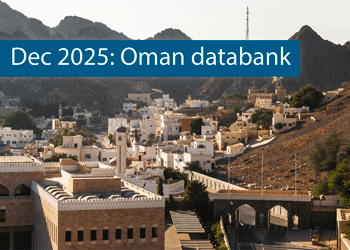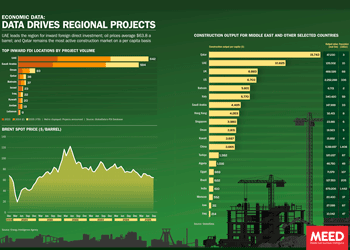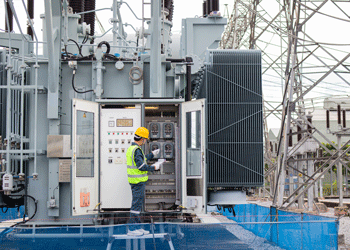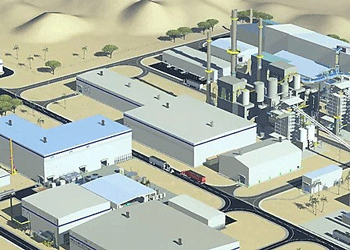Top 10 plans for Saudi Arabia’s $1 trillion capital
27 July 2023

> This package also includes: Saudi Arabia plans $1 trillion capital
Register for MEED's guest programme
1. New Murabba
In early 2023, Saudi Arabia’s Crown Prince Mohammed bin Salman bin Abdulaziz al-Saud launched New Murabba Development Company (NMDC) to develop the world’s largest modern downtown in Riyadh.
Located to the northwest of the capital, the development will cover an area of 19 square kilometres. It will feature more than 104,000 residential units, 9,000 hotel rooms and over 980,000 square metres of retail space.
The centrepiece will be the Mukaab, a 400 cubic-metre structure that will be the world’s first immersive destination, featuring digital and virtual technology. The Mukaab will include a tower atop a spiral base.
The estimated project cost is more than $50bn and it is scheduled for completion by 2030.
 Contractors win New Murabba early works deals
Contractors win New Murabba early works deals

UK consultancy firm Atkins is working on the New Murabba project in Riyadh, which includes the 400-metre-cubed, Najdi-inspired Mukaab building. Another UK firm, Buro Happold, is working with Atkins on the project
2. Diriyah Gate
Announced in 2019, the Diriyah Gate project spans 7.1 million sq m to the northwest of Riyadh. The masterplan includes the three-phased development of several areas in Diriyah, including Wadi Safar, Wadi Hanifah Park, Bujairi District, Arts District, Samhan District and Diriyah Square.
Projects worth $12.6bn are in execution at Diriyah Gate, according to regional projects tracker MEED Projects, while $9.5bn-worth of schemes are in design and tendering stages.

Artist's rendition of Diriyah Gate’s King Salman Square, one of the meeting places planned for the 7.1 million square-metre development
3. King Salman Park
King Salman Park is being built on more than 16 sq km and will become the world’s largest urban park. The project was officially announced in 2019 and is split into three phases.
Saudi-based Modern Building Leaders is building the SR7.5bn ($2bn) Royal Art Complex. A joint venture of Freyssinet Saudi Arabia and the local Haif Company is carrying out the infrastructure works. Freyssinet is also delivering the main works package for the visitors’ centre at the park, and Saudi-based E A Juffali & Brothers is providing mechanical, electrical and plumbing services.
At King Salman Park, projects worth more than $5bn are in execution, while projects under design and tender are valued at about $2.7bn.
 Contractors win $2.5bn of work at King Salman Park
Contractors win $2.5bn of work at King Salman Park

Covering an area of 16.9 sq km, King Salman Park is located to the south of King Abdullah Road, to the north of Makkah al-Mukkarramah Road and to the west of the Eastern Ring Road. The east of the site has a military airbase with two runways
4. Sports Boulevard
Riyadh Sports Boulevard was unveiled in March 2019 by King Salman bin Abdulaziz al-Saud. The development will span 135km on Prince Mohammed bin Salman bin Abdulaziz Road.
The project will be split into eight zones and features the development of 50 sports facilities, arts and recreational facilities, and green and open spaces spanning 4.4 million sq m. As of March 2023, $3.1bn-worth of projects had been awarded.
In early 2023, the local Almabani secured a $2bn contract for the construction of five packages of the project.
Sports Boulevard Foundation invited firms to submit bids in early August for a contract to provide project management consultancy services for schemes that include several iconic buildings at Sports Boulevard.

Sports Boulevard runs across Riyadh from east to west. Once complete, it will be the world’s longest park at over 135km
5. Seven
Saudi Entertainment Ventures (Seven), a wholly owned subsidiary of the Public Investment Fund (PIF), began construction on the first of its two entertainment districts in Riyadh in January 2022. Named Exit 10, the project is being executed by Indian contractor Shapoorji Pallonji, which secured a deal worth more than $370m.
Exit 10 is at the most advanced stage of construction out of the 21 planned entertainment complexes in 14 cities across the kingdom.
A second entertainment district, Exit 15, is under construction in the Al-Nahdah area of Riyadh. The contractor on the scheme is Consolidated Contractors Company, and US-based Aecom is the consultant. The project is expected to be completed by the end of 2025.
6. Misk Nonprofit City
Mohammed bin Salman Nonprofit City (Misk) is a masterplanned development covering 3.4 sq km in Riyadh. It includes commercial, educational, cultural, exhibition, hospitality, residential and retail spaces located in different zones.
In November 2021, Crown Prince Mohammed bin Salman announced that the Misk Foundation development will be the world’s first non-profit city.
The consultants working on the project include Germany’s Albert Speer + Partner as masterplanner and architect, and UK-based Buro Happold as engineer. The project manager for the first phase of construction is UK-based Mace.
7. King Salman International airport
The development of King Salman International airport was announced in November 2022 by Crown Prince Mohammed bin Salman. The project is backed by PIF and will span an area of about 57 sq km.
The airport is expected to be one of the world’s largest, and will be powered by renewable energy.
It aims to accommodate 120 million passengers by 2030 and 185 million passengers by 2050, with the capacity to process 3.5 million tonnes of cargo.
The airport will have six parallel runways and will include the existing terminals at King Khalid International airport.

If completed on time in 2030, King Salman International airport will become the world’s largest airport in terms of passenger capacity
8. Roshn
Launched by PIF, Roshn is an initiative by the government to promote real estate sector activity in the kingdom and increase homeownership rates among Saudi citizens to 70 per cent by 2030.
Roshn is developing the Sedra community in northeast Riyadh, which is masterplanned to include 30,000 homes. Construction work is ongoing on packages from phases one and two.
Warefa is Roshn’s second community project. Located in the Al-Janadriyah district of Riyadh, it was announced in March 2023. The project will cover 1.4 million sq m and have more than 2,000 housing units.

Public Investment Fund-backed Roshn has integrated power-saving technologies and adopted water treatment and reuse across the communities it is developing in the kingdom
9. NHC Housing schemes
National Housing Company (NHC) is the investment arm of the Municipal, Rural Affairs & Housing Ministry in the residential and commercial real estate sectors. Its main suburban developments in Riyadh are Khuzam and Al-Fursan.
According to data from MEED Projects, packages worth over $784m are under execution in Khuzam.
In February, NHC announced the second phase, spanning more than 21 million sq m and including 30,000 homes.
NHC and Saudi Arabia’s Housing Ministry have also signed investment agreements totalling more than SR24bn ($6.4bn) to launch the Al-Fursan suburb in northeast Riyadh.
It is the largest scheme in terms of the area and the number of housing units that NHC is implementing in partnership with Saudi real estate developers. Delivery of the first batch of homes is set for 2026.
10. North Pole
PIF is planning a 2km megatall tower as part of an 18 sq km masterplanned development to the north of Riyadh.
The proposed tower will be more than double the height of the world’s tallest building, Dubai’s Burj Khalifa, which is 828 metres tall. The project could cost about $5bn to construct.
Several international architecture firms have been invited to participate in a design competition for the project. UK-headquartered EY conducted the feasibility study for the development.
 Gigaproject seeks firms for Riyadh rail link
Gigaproject seeks firms for Riyadh rail link
Qiddiya has sought consultants for its Q-Express rail link that will connect the entertainment city with King Salman airport

Main image credit: Riyadh Expo 2030
Exclusive from Meed
-
 Navigating financial markets amid geopolitical fragmentation
Navigating financial markets amid geopolitical fragmentation28 December 2025
-
 Oman’s growth forecast points upwards
Oman’s growth forecast points upwards24 December 2025
-
 December 2025: Data drives regional projects
December 2025: Data drives regional projects23 December 2025
-
 Local firm bids lowest for Kuwait substation deal
Local firm bids lowest for Kuwait substation deal22 December 2025
-
 Saudi-Dutch JV awards ‘supercentre’ metals reclamation project
Saudi-Dutch JV awards ‘supercentre’ metals reclamation project22 December 2025
All of this is only 1% of what MEED.com has to offer
Subscribe now and unlock all the 153,671 articles on MEED.com
- All the latest news, data, and market intelligence across MENA at your fingerprints
- First-hand updates and inside information on projects, clients and competitors that matter to you
- 20 years' archive of information, data, and news for you to access at your convenience
- Strategize to succeed and minimise risks with timely analysis of current and future market trends

Related Articles
-
 Navigating financial markets amid geopolitical fragmentation
Navigating financial markets amid geopolitical fragmentation28 December 2025

As we move towards 2026, geopolitical fragmentation is no longer a background risk that occasionally disrupts markets.
It has become a defining feature of the global financial landscape. Shifting alliances, persistent regional tensions, sanctions and the reconfiguration of supply chains are reshaping how capital flows, how liquidity behaves and how confidence is formed.
For firms operating in the Middle East, this does not simply mean preparing for more volatility. It means operating in a system where the underlying rules are evolving.
For much of the past three decades, businesses and investors worked within a broadly convergent global framework. Trade expanded, financial markets deepened and policy coordination – while imperfect – created a sense of predictability. That environment has changed.
Today, economic decisions are increasingly influenced by strategic alignment, security considerations and political resilience. Markets still function, but they do so in a more fragmented and less forgiving way.
Shifting landscape
One of the most important consequences of this shift is that risk no longer travels along familiar paths. In the past, geopolitical events were often treated as temporary shocks layered onto an otherwise stable system.
Today, they shape the system itself. Trade flows are influenced as much by political compatibility as by cost efficiency. Supply chains, once optimised for speed and scale, are reorganising into regional or allied clusters. Financial markets respond not only to data, but to narratives about stability, alignment and long-term credibility.
This change places greater pressure on firms that rely on historical relationships to guide decisions. Models built on past correlations – between interest rates and equity markets, or between energy prices and regional growth – are less reliable when markets move between different regimes. The challenge is not simply higher volatility, but the fact that correlations themselves can shift quickly.
Monetary policy adds a second layer of complexity. Major central banks are no longer moving in step. The US, Europe and parts of Asia face different inflation dynamics and political constraints, leading to diverging interest-rate paths.
For the GCC, where currencies are largely pegged to the US dollar, this divergence has direct consequences. Local financial conditions are closely tied to decisions taken by the Federal Reserve, even when regional economic conditions follow a different cycle.
This matters because funding costs, liquidity availability and hedging conditions are shaped by global rather than local forces. When US policy remains tight, dollar liquidity becomes more selective. When expectations shift abruptly, market depth can disappear quickly.
For firms with international exposure, long-term investment plans, or reliance on external financing, these dynamics require careful management. They cannot be treated as secondary macro considerations.
Energy markets further complicate the picture. The Middle East remains central to global energy supply, which means geopolitical events often interact with oil prices and financial conditions at the same time.
When shifts in energy expectations coincide with changes in global interest-rate sentiment, liquidity conditions can tighten rapidly. This interaction is well known in academic research on fixed exchange-rate systems, but its practical implications are often underestimated in corporate planning.
Expanding vulnerabilities
These dynamics expose clear vulnerabilities. Concentrated supply chains are more susceptible to disruption. Financing structures dependent on continuous market access are more exposed to sudden repricing. Risk management approaches that assume stable relationships between assets are more likely to disappoint. Operational risks – particularly in technology and data – are increasingly shaped by geopolitical considerations rather than purely technical ones.
At the same time, the region enters 2026 from a position of relative strength. GCC economies benefit from fiscal buffers, long-term investment programmes and a growing perception of stability compared to other parts of the world. In an environment where uncertainty is widespread, predictability itself becomes valuable. Capital increasingly seeks jurisdictions that combine economic ambition with institutional credibility.
The question, therefore, is not whether opportunities exist, but whether firms are prepared to capture them responsibly. This requires a shift in how future risks are assessed and embedded into decision-making. Linear forecasts and static plans are insufficient when the environment itself can change state. Scenario thinking must evolve beyond optimistic and pessimistic cases to reflect different combinations of geopolitical alignment, monetary conditions, and supply-chain stability. These scenarios should inform capital allocation, not sit in strategy documents.
Liquidity and risk management discipline also become central. In both trading and corporate finance, experience shows that many failures stem not from being wrong on direction, but from being overexposed when conditions change. Scaling risk to market conditions, maintaining funding flexibility and understanding how quickly liquidity can evaporate are essential practices. This is as true for corporate balance sheets as it is for trading books.
Operational resilience must be viewed through the same lens. Supply-chain redundancy, cybersecurity preparedness and data governance are no longer purely operational concerns. They influence financial stability, investor confidence and regulatory trust. In a fragmented world, operational disruptions can quickly translate into financial and reputational damage.
Facing the future
As we approach 2026, leadership in the Middle East faces a clear test. The global environment is unlikely to become simpler or more predictable. Firms that continue to rely on assumptions shaped by a different era will find themselves reacting rather than positioning. Those that invest in disciplined risk management, flexible planning and operational resilience will be better placed to navigate uncertainty and to turn volatility into strategic advantage.
In this environment, risk management is not an obstacle to growth. It is the framework that makes sustainable growth possible.
Ultimately – and this is an often overlooked critical point – none of these adjustments, whether in scenario planning, liquidity discipline, or operational resilience, can be effective without the right human capital in place.
Geopolitical fragmentation and financial volatility are not risks that can be fully addressed through models or policies alone. They require informed judgement, institutional memory and the ability to interpret weak signals before they become material threats or missed opportunities.
Firms that succeed in this environment will be those that deliberately invest in corporate knowledge: building internal capabilities where possible and complementing them with external expertise where necessary. This means involving professionals with the right background, cross-market experience and a proven, proactive approach to risk awareness and governance.
In a fragmented world, competitive advantage increasingly depends not only on capital or strategy, but on the quality of people entrusted with understanding risk, challenging assumptions and guiding decision-making under uncertainty.
 https://image.digitalinsightresearch.in/uploads/NewsArticle/15306336/main.gif
https://image.digitalinsightresearch.in/uploads/NewsArticle/15306336/main.gif -
 Oman’s growth forecast points upwards
Oman’s growth forecast points upwards24 December 2025

MEED’s January 2026 report on Oman includes:
> COMMENT: Oman steadies growth with strategic restraint
> GVT & ECONOMY: Oman pursues diversification amid regional concerns
> BANKING: Oman banks feel impact of stronger economy
> OIL & GAS: LNG goals galvanise Oman’s oil and gas sector
> POWER & WATER: Oman prepares for a wave of IPP awards
> CONSTRUCTION: Momentum builds in construction sectorTo see previous issues of MEED Business Review, please click herehttps://image.digitalinsightresearch.in/uploads/NewsArticle/15306449/main.gif -
 December 2025: Data drives regional projects
December 2025: Data drives regional projects23 December 2025
Click here to download the PDF
Includes: Top inward FDI locations by project volume | Brent spot price | Construction output
MEED’s January 2026 report on Oman includes:
> COMMENT: Oman steadies growth with strategic restraint
> ECONOMY: Oman pursues diversification amid regional concerns
> BANKING: Oman banks feel impact of stronger economy
> OIL & GAS: LNG goals galvanise Oman’s oil and gas sector
> POWER & WATER: Oman prepares for a wave of IPP awards
> CONSTRUCTION: Momentum builds in construction sectorTo see previous issues of MEED Business Review, please click herehttps://image.digitalinsightresearch.in/uploads/NewsArticle/15306140/main.gif -
 Local firm bids lowest for Kuwait substation deal
Local firm bids lowest for Kuwait substation deal22 December 2025
The local Al-Ahleia Switchgear Company has submitted the lowest price of KD33.9m ($110.3m) for a contract to build a 400/132/11 kV substation at the South Surra township for Kuwait’s Public Authority for Housing Welfare (PAHW).
The bid was marginally lower than the two other offers of KD35.1m and KD35.5m submitted respectively by Saudi Arabia’s National Contracting Company (NCC) and India’s Larsen & Toubro.
PAHW is expected to take about three months to evaluate the prices before selecting the successful contractor.
The project is one of several transmission and distribution projects either out to bid or recently awarded by Kuwait’s main affordable housing client.
This year alone, it has awarded two contracts worth more than $100m for cable works at its 1Z, 2Z, 3Z and 4Z 400kV substations at Al-Istiqlal City, and two deals totalling just under $280m for the construction of seven 132/11kV substations in the same township.
Most recently, it has tendered two contracts to build seven 132/11kV main substations at its affordable housing project, west of Kuwait City. The bid deadline for the two deals covering the MS-01 through to MS-08 substations is 8 January.
https://image.digitalinsightresearch.in/uploads/NewsArticle/15305745/main.gif -
 Saudi-Dutch JV awards ‘supercentre’ metals reclamation project
Saudi-Dutch JV awards ‘supercentre’ metals reclamation project22 December 2025
The local Advanced Circular Materials Company (ACMC), a joint venture of the Netherlands-based Shell & AMG Recycling BV (SARBV) and local firm United Company for Industry (UCI), has awarded the engineering, procurement and construction (EPC) contract for the first phase of its $500m-plus metals reclamation complex in Jubail.
The contract, estimated to be worth in excess of $200m, was won by China TianChen Engineering Corporation (TCC), a subsidiary of China National Chemical Engineering Company (CNCEC), following the issue of the tender in July 2024.
Under the terms of the deal, TCC will process gasification ash generated at Saudi Aramco’s Jizan refining complex on the Red Sea coast to produce battery-grade vanadium oxide and vanadium electrolyte for vanadium redox flow batteries. AMG will provide the licensed technology required for the production process.
The works are the first of four planned phases at the catalyst and gasification ash recycling ‘Supercentre’, which is located at the PlasChem Park in Jubail Industrial City 2 alongside the Sadara integrated refining and petrochemical complex.
Phase 2 will expand the facility to process spent catalysts from heavy oil upgrading facilities to produce ferrovanadium for the steel industry and/or additional battery-grade vanadium oxide.
Phase 3 involves installing a manufacturing facility for residue-upgrading catalysts.
In the fourth phase, a vanadium electrolyte production plant will be developed.
The developers expect a total reduction of 3.6 million metric tonnes of carbon dioxide emissions a year when the four phases of the project are commissioned.
SARBV first announced its intention to build a metal reclamation and catalyst manufacturing facility in Saudi Arabia in November 2019. The kingdom’s Ministry of Investment, then known as the Saudi Arabian General Investment Authority (Sagia), supported the project.
In July 2022, SARBV and UCI signed the agreement to formalise their joint venture and build the proposed facility.
The project has received support from Saudi Aramco’s Namaat industrial investment programme. Aramco, at the time, also signed an agreement with the joint venture to offtake vanadium-bearing gasification ash from its Jizan refining complex.
Photo credit: SARBV
https://image.digitalinsightresearch.in/uploads/NewsArticle/15305326/main.gif

